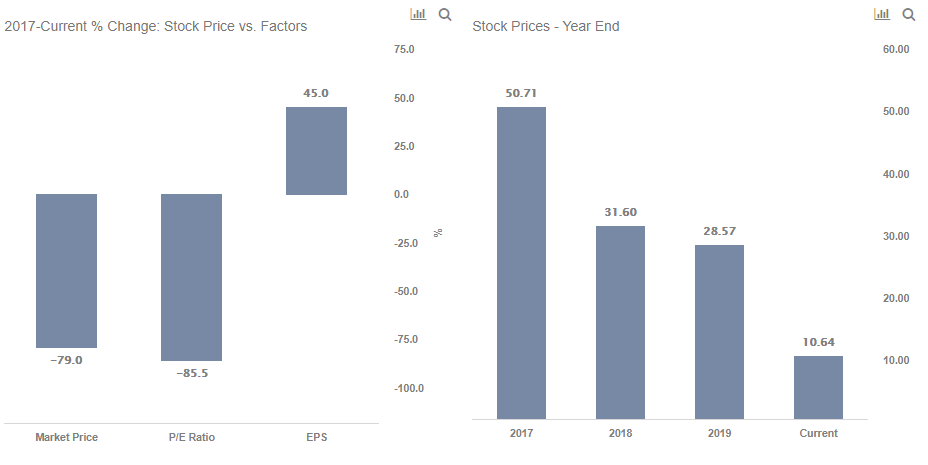Why American Airlines Stock Has A Sizable Downside Risk Even At $9
American Airlines’ stock (NASDAQ: AAL) has declined by 63% since the beginning of this year, currently trading at a seven-year low of just $9 per share, and we believe that the company faces a huge credit risk due to the surmounting debt load of $24 billion. Recently, the company raised an additional $2 billion in debt and was granted $5.8 billion under the payroll support program by the U.S. government. The company’s debt to capital ratio of 1:3 is higher than that for competitors Delta Airlines and United Airlines, which could lead to solvency issues and hurt the stock further if the demand for air travel doesn’t pick up quickly enough over the coming quarters.
As we point out in our dashboard Why American Airlines’ Stock moved 80%, the company’s stock has declined steadily since the beginning of 2018 primarily due to its shrinking operating margin despite a moderate growth in revenues. After the bankruptcy proceedings in 2012, a third of the company’s $16 billion of long-term debt was expected to mature by 2018. However, the company kept on adding to its debt pile – which has now grown to $24 billion. Moreover, the company has returned $14 billion to investors through share repurchase and dividend payouts despite a shrinking operating margin – a decision that is proving to be a really bad one with the benefit of hindsight.
With the suspension of the capital return program due to the coronavirus pandemic, the company’s shares outstanding are likely to remain flat until the near-term outlook for the air travel industry turns positive. Also, the equity investors losing out on the modest 1.5% dividend yield they were receiving in the last few years.
- Should You Pick American Airlines Stock At $14 After A 6% Fall In A Week?
- With 20% Gains This Month Is Alaska Air A Better Pick Than American Airlines Stock?
- Which Airlines Stock Will Offer Better Returns – American Or United?
- What To Expect From American Airlines’ Q2?
- Will American Airlines Stock Recover To Its Pre-Inflation-Shock Level?
- Pick Either American Airlines Stock Or Its Peer – Both May Offer Similar Returns
Taken together, all these factors have resulted in American Airlines’ P/E ratio shrinking from 20 at the end of 2017 to around 2.5 now. While the company is likely to incur losses for the full year 2020, we believe there is a strong downside for AAL stock due to slow expected recovery in passenger air travel demand and the growing risk of default on its long-term obligations.
So what’s the likely trigger and timing to this downside?
All Airlines have reduced capacity by almost 60% by grounding nearly half of their fleet. As the COVID-19 pandemic continues to restrict population movement as a containment measure, the demand for transportation services globally is likely to remain subdued for a couple of months at least. Also, there has been a resurgence of COVID-19 cases in many countries, which could further delay international travel demand until the global coronavirus crisis shows signs of abatement.
Our dashboard forecasting US COVID-19 cases with cross-country comparisons analyzes expected recovery time-frames and possible spread of the virus. Further, our dashboard -28% Coronavirus crash vs. 4 Historic crashes builds a more complete macro picture. It complements our analyses of coronavirus impact on a diverse set of American Airlines’ peers including Delta and United. The complete set of coronavirus impact and timing analyses is available here.
Notably, American Airlines is targeting a $12-billion reduction in operating and capital expenditure for the full year in a bid to make its cash last. In comparison, its peer Delta Airlines has announced a $5-billion expense management program for Q2 – with the savings expected to come from across Delta Airlines’ Expense components.
See all Trefis Price Estimates and Download Trefis Data here
What’s behind Trefis? See How It’s Powering New Collaboration and What-Ifs For CFOs and Finance Teams | Product, R&D, and Marketing Teams

